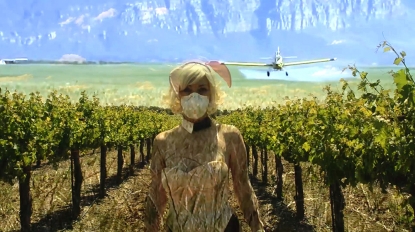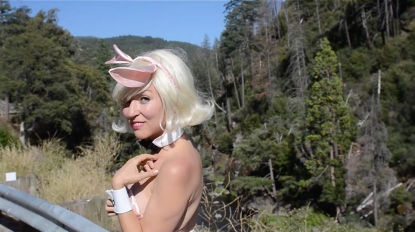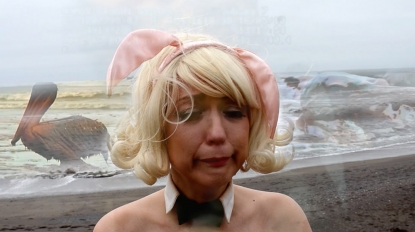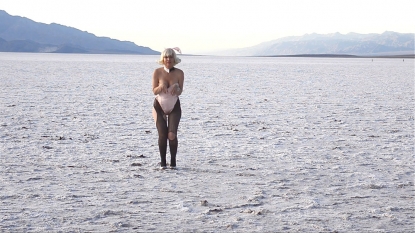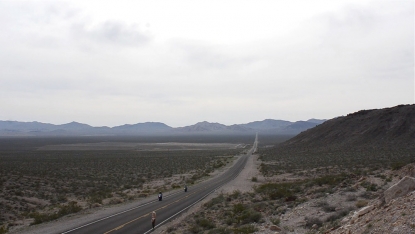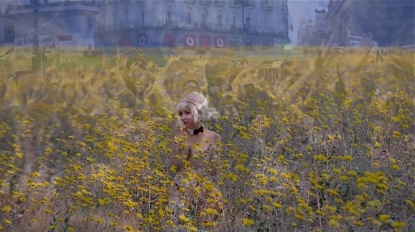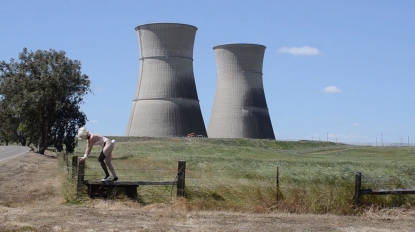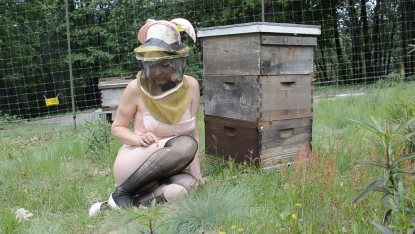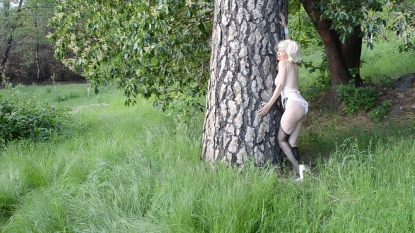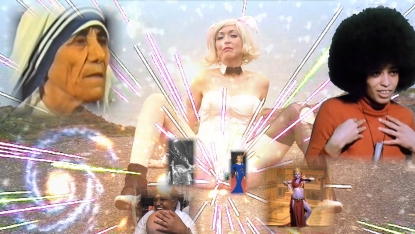Feature: Conversations
A Bunny Thing Happened - A conversation with Monet Clark
If ever a species would be justified in bringing a class action defamation suit Bunnies v Hefner would be be taught in every law school in the land. The iconic Playboy Bunny is the most salacious anthropomorphic depiction of a rodent since Bugs went Trans to seduce Elmer Fudd. And in the prototypical days of feminist discourse she was a veritable mascot. Several proto feminists, the least of which was Gloria Steinem investigated the vocation and actually become part of the hutch of rabbit waitresses that serviced the 40 Playboy Club joints spread all over the globe (including a San Francisco location that opened in 1965 and closed in 1978!) Feminism and the Playboy Bunny grew up together… at different rates with varying success
Monet Clark takes this investigation one high heel step further in Bunny Girl as she exposes herself navigating over a thousand miles of the harsh terrain of California and Nevada - both urban and rural. A minor comedic masterpiece as well as a revival of the video art landscape genre of Mary Lucier, Doug Hall and Nan Hoover, Bunny Girl is a rock solid performative piece, with Clark in the titular role, that sets out to interlace dialogs of feminist issues and environmental activism.
Monet is Marilyn (or at least a satire of Marilyn ala Edie Adams) at first glance but then deflates into a Chaplinesque "little tramp" as she stumbles alone through the ultimately uncaring landscape. Her unrequited adoration of nature eventually leads her to a dead end where she reaches inward and yanks out a gynecological explosion that has to be seen to be believed.
What follows is a transcript of a gab fest Monet and I had while watching the piece in real time in a virtual directors commentary.
– Dale Hoyt
Dale Hoyt: So was there a conscious aim to look like Marilyn and her whole history with Playboy Magazine?
Monet Clark: There was some inspiration there, I don’t know about her Playboy era, but I mean any time you don a platinum wig I think you’re referencing Marilyn.
DH: Well if it’s...
MC: ...short and curled.
DH: Yes.
MC: I was also thinking of the TV show The Girls Next Door, the Hugh Hefner reality show with his three girlfriends.
DH: Oh yah yah.
MC: That was it also, but Marilyn’s in there a lot.
DH: That’s a grotesque show.
MC: I thought it was interesting in many ways. I always see grotesque and beauty side by side.
DH: OK, so you’re wearing high heels and you’re having a terrible time with the high heels. Is that like a reference to torture?
MC: Ha ha ha.
DH: …or foot binding?
MC: The shoes are low-heeled closed toe pump, like what the women wore when the Playboy outfit was first introduced. Mine were actually super comfortable. The cufflinks have the Playboy Bunny logo stamped on them. I wanted authentic, they wore the black stockings like I had. I’m having a terrible time in the shoes, because I’m having a terrible time with a lot of things. I’m just having trouble.
DH: So now very early on Bunny Girl gets uncomfortable. She looks like she’s more like crying for herself and her own discomfort, but it eventually it becomes more empathetic pain. But this early part just seems to be her being uncomfortable and dealing with her own physical discomfort.
MC: I think its part in parcel, it’s the same thing. Bunny Girl is a metaphor for the vulnerability of our planet, our ecosystems, the animals... She’s also just distressed. In the scene that’s reflected behind her I literally cried every time I saw it. She’s upset about that and internal things. I mean my own personal history of course is that I have Environmental Illness (EI), which is a direct result of things found in the footage, the global condition of poisoning. So it’s all of it...
DH: your Environmental Illness...
MC: Yeah it’s literal and its metaphorical, external and internal, because what we do to our environment we do to ourselves. No one knows that better than people with EI.
DH: Bunny Girl’s a very solitary figure.
MC: Ha ha ha.
DH: She’s never seen with anyone. She’s really alone in the world and in a way she’s sort of a Chaplin-esque figure... because Chaplin did a lot of things where he was walking away from the camera, in a desert, or in a bleak landscape.
MC: Well he had a lot of sorrow, like Bunny Girl.
DH: And she’s often seen walking away. Talk about her as a solitary figure.
MC: Well we all die alone. We all go through our journey in life essentially alone, as far as what happens internally. No one can go through your life for you. I think she’s set out into the wilderness to come to terms with some things. So she’s in a way on a vision quest or something. She’s on a journey.
DH: Although we never see her origin. If you were to do a sequel that would have her origin story what would it be?
MC: (laughs) Oh God I could think of hilarious things, but she’s a product of society and culture and influences good and bad. Her origin is the 20th century and she’s grown into the 21st century, so she’s now. She’s a contemporary chick, very much so, a product of our time.
DH: Yes for sure.
MC: She’s a dichotomy.
DH: Now this is what I call the Paris, Texas shot. It’s one of the more gorgeous, of the many gorgeous landscapes that you use. The irony I thought, when I saw it this time, is that Paris, Texas was sort a male empowerment piece. It was about sort of the loneliness of being a man and basically how worthless men are...
MC: …the expectations they’re under, which inevitably they fail to fulfill.
DH: And the last shot is Harry Dean Stanton just going off into the highway having reunited the son and the mother, the mother being all the son really needs. But this is sort of a female version of that in a way.
MC: She’s coming to terms with herself and with grief. She’s being forced to slow down. She’s really looking at the natural world and realizing the magnitude of global suffering, with the mass species die off that’s happening now for instance. It’s overwhelming and its just the beginning.
DH: Didn’t you feel like someone in the passing cars could stop and attack you, I mean how far was Jared? [Jared Johnson, editor and camera assistant]
MC: Yeah he was ready to run down the hill from where I set up the camera. He almost did when one car stopped. So this is where she’s meditating and just hanging out with the cactuses, ‘cause that’s what they do their whole life span. They just be.
DH: Well, they’re plants.
MC: Yeah, but plants are alive. You didn’t ask about the alien scene.
DH: I didn’t really have anything to say about that.
MC: That’s just a little nod to conspiracy theorists.
DH: Oh. She also reverts to her Bunny self. The only time we see her hop is in this scene in the salt flats, which by the way is hysterical physical comedy.
MC: She gets to be anthropomorphic.
DH: And she looks so hyper vigilant when she gets into her bunny mode, because you know bunnies are nerve wracked animals, because they are so vulnerable.
MC: Well vulnerability is a big theme. I like this dialogue about ‘rape culture’ lately. It’s really interesting. Camille Paglia used to say ‘well if you go into a frat house and everyone’s drunk of course you’d expect to get raped so don’t put yourself in that position’. And I used to be think ‘yeah that’s the way it is, and it’s stupid to expect different’.
Now I’m feeling, why do we have to accept rape culture? I’m seeing a time when it actually could be different. There is a parallel between the vulnerability of the sexuality of women and the vulnerability of our environment/nature. The mentality that destroys the natural world without conscience, to the point now that the eco-systems are so out of balance we are beginning to feel the vulnerability climate change poses, that mentality is the same mentality that rapes women. It’s the same mentality that marginalizes the indigenous perspective, that doesn’t care if humans or animal suffer. It suppresses the feminine nature within. It’s the same mentality. Bunny Girl is just a product of this world. Trying to exist within it and find her own strength.
DH: There is also something you hear, from anti-environmental people or whatever you call them, they say ‘well nature’s a pretty harsh existence too, for centuries people were in battle with nature, so its not as easy as...’
MC: My answer to that is back to the concept of balance. We need to recognize that we live in a global ecosystem that has certain needs to stay in balance, in order for us to survive. We can have civilization, convenience and comfort, and develop technology that supports the balance of the planet. We can have both. There doesn’t have to be a battle between the masculine and feminine natures. We just need to change our mentality. We’ve tried to conquer and now nature is coming back with even more fury. The environmentalist’s perspective has to stop getting marginalized by being portrayed as some hippy cliché. I wish the word environmentalist would conjure up a different image, like a serious scientist. Bunny Girl is an environmentalist. (laughs) Doesn’t she look like one?
DH: Sure.
DH: The idea that men and women are implicitly in battle is this crazy thing that we’re about to see manifest in Trump vs Clinton. It’s basically going to be the ultimate war between the men and the women.
MC: A gladiator spectacle.
DH: Ok now you really get some beautiful shots here were you conflate the protestors with the flowers and the sort of multitudes, the fact that there’s multitudes of flowers and that there’s...
MC: over population of people on the planet now.
DH: But also the activist protestors are there and yet Bunny Girl is sort of again very solitary. She is sort of lording over them, but isolated and also sort of relishing being amongst them.
MC: And people are just like flowers. They come and they go. Life is pretty short. Flowers come up, bloom putting out this beautiful scent. They have their fertility day and then poof, they’re gone. In those fields of flowers, she’s brought very into a sensual now, yet she’s in touch with what’s going on in the world. But yeah it comes into her in a collective unconscious kind of way or in an intuitive way.
DH: But at the same time she wearing the most artifice laden, synthetic outfit that you can imagine. I mean she doesn’t look like she’s from the earth, she doesn’t look like an earth mother.
MC: But see every synthetic thing comes from materials that come out of the earth. That’s the dichotomy. Everything you see everywhere comes out of the earth. We’re all earth mothers and earth fathers. Humans are all created from the earth, as well as born out of culture. So even indigenously people who live really close to the Earth, are born out of culture. Their social etiquette and traditions and the meaning that they place on dress and objects, they’re all dictated by their culture. That’s part of being human.
DH: And all culture is materialistic so it’s redundant to say a materialistic culture, because that’s the purpose of culture. Where is this by the way?
MC: Rancho Seco, south of Sacramento, it’s a decommissioned nuclear power plant.
DH: How many miles did you cover in the making of Bunny Girl?
MC: Well, I don’t know. We were in Tahoe National Forest; we were in Nevada County, California; Death Valley and Beatty, Nevada; south of Sacramento; we were in the Marin Headlands, Emeryville and San Francisco.
DH: So at least about 1000 miles 1500. Very impressive.
MC: This is the poisoning scene.
DH: Well of course being a film nerd I think about...
MC: ...Hitchcock. Of course. This is the modern Hitchcock, the crop dusting is poisoning you, it’s not just a scary airplane, its the scary chemicals.
DH: But that whole scene in North By North West, he gets crop dusted on then he runs out and the oil tanker blows up, if you wanted you could make it into some kind of environmental fable. You could interpret that scene that way. So this is hysterical. Bunny Girl with the apiary beekeeping suit with her ears sort of plastered down...
MC: ...on top of the hat.
DH: This makes for another comparison, an iconic 80’s film... its a little Blue Velvety, a piece about the birds and the bees. You had the birds earlier and now you got the bees.
MC: The bees are kind of a big crux of the piece. One might not realize it, if one doesn’t know a lot about bees, but beehives are female societies where females run everything. And they live in sacred geometry. They’re about as utopian a society as you can get. And they are vulnerable right now, to the pesticides being sprayed. They’re vulnerable like all those sea animals washing up on the shores in the beginning of the piece. That all happened in the last few months.
DH: Bee culture is like a matriarchy and a monarchy.
MC: And they were covered in pollen. I was watching them covered in this bright orange pollen and they were blissed out. It was a very blissful experience for me to be sitting there, vulnerable that I might get stung, but nevertheless blissful.
DH: I know because despite the fact that you had your headgear on you were more or less naked. Now at this point you can’t deny that this is eco-sexual. This is a very eco-sexual piece.
MC: Well there’s a buzzing life force energy in all of nature. When you hug a tree you actually can feel it. It’s pretty extraordinary.
DH: Can you talk about what your inspiration with the eco-sexual movement has been?
MC: There’s been absolutely none. (laughs) I just made this film and then realized I kinda of understood maybe a bit of where they’re coming from. I’ve had very little exposure really.
DH: And yet this could be a commercial for them.
MC: Well I’ve had a relationship to the natural world most my life. As a young child I had the privilege to feel its aliveness all around me, out in the Santa Monica mountains. We lived on a 360-acre parcel of land boarded by the national park, so I’d hike around all day by myself and never see another person. It’s not been a sexual or eco-sexual experience for me, but more of a mystical one and a medicinal one, because I grew up where everyone had a basic knowledge of the healing properties of plants. I would imagine those are part of the eco-sexual philosophy too though. And I think that intellectual ideas hit us all simultaneously. It just comes in. There’s a shifting consciousness and concern for our natural environment, because of what’s happening to it. So I think it would be only natural to turn to understanding that philosophy to some to degree, if you’re concerned about these issues.
DH: So now Bunny Girl has come to the city.
MC: She’s come back.
DH: She’s come back?!
MC: Yeah.
DH: How did we know? I didn’t know she came from the city?
MC: Yeah, well her outfit is a clue! And she was so sped up and stressed out before.
DH: And did you work in tandem with the homeless people or so you just sort of work around them?
MC: Oh I went there and asked them all if they wouldn’t mind if I filmed, and they gave me permission and I filmed.
DH: Did that one guy come out on cue?
MC: No, no he was just doing whatever he was doing.
DH: In his own nature, ‘cause really the people that have returned to nature are the homeless. OK, so you’re at the end of your road.
MC: The end of civilization as we know it, if we don’t get our shit together and listen to our feminine sides.
DH: OK, we have to talk about something, vulvanic display.
MC: Gawd.
DH: This reminds me a little bit of Judy Chicago and her dinner plates, in as far as a lot of people were horrified that she would just reduce these women who she was supposedly paying homage to, to their vulvanic display. And you’ve basically got all these women that you admire and they’re sort of being ejected from your vagina. So could you like talk about that um irony or some people would call it a problem... I would just call it irony.
MC: OK, there are so many ways to look at this. For one thing we all come from a woman’s body so there’s nothing problematic about that ya know. It’s a birthing pose, its a sexual pose, its a stripper pose, its a mother goddess pose, its a powerful pose, its a lot of poses, its a vulnerable pose. In eastern spirituality the creative center is in the 2nd Chaka, which is where the internal female organs are. From here you give birth to ideas. So to me I’m giving birth to ideas, born out of the influence of these women. That’s part of what this scene is about.
DH: OK. Oh by the way, I was Angela’s Davis’ projectionist for a day at the Art Institute.
MC: How exciting!
DH: Very exciting. Umm, the reason I talk about vulvanic display is because it also goes back to Annie Sprinkle and one of her most famous early pieces the Cervix Piece where she satirized sort of, the vulvanic display competition that was going on between Playboy, Penthouse and Hustler, you know. They were like opening up vaginas further and further in pictorials. It got to the point where she said well if you really want to see in there, lets take a look all the way in with a speculum and a flash light. And she did. And when I saw it, it was fascinating. It was very funny and I don’t know if she realized, but I imagine she did, the symbology of it, since the cervix looked like a great big eye looking back at you.
MC: It’s the hidden space, the dark mystery ya know, that internal feminine space. But in the piece there’s no vulva. We need to be clear, it’s covered up by the pink fabric of the Playboy Bunny outfit! Plus light, shimmering fireworks and images. So you see no skin...
DH: No.
MC: But it’s an ancient pose, ya know, you’ll see this in the ancient drawings and sculptures from all kinds of cultures.
DH: Venus.
MC: She’s giving birth to the new paradigm shift which will help save the world over the next 200 years, if we usher in a balance of the masculine and feminine. It’s a Utopian ideal. It’s also kind of Warholian and glamorous.
DH: Warholian?
MC: Like his silk-screened portraits that he did of everybody, which were like giving them a face lift ya know. It’s pink and green, it has a pop culture look.
DH: And there is a Star Wars element to it.
MC: (laughs)
DH: There is.
MC: The mysteries of deep space, the existential questions, they’re all coming out of her.
DH: Lets see the rest of the end...
MC: That’s Poison Ivy from The Cramps.
DH: Jane Fonda, Exene...
MC: Jane Goodall, Carolee Schneemann...
DH: I just dig it, I love it. We’re all Bunny Girl
MC: We are, we’re all Bunny Girl (Laughs)
Bunny Girl is on view April 22-June 4, 2016 at Krowswork in Oakland
http://www.krowswork.com/thefates.html

